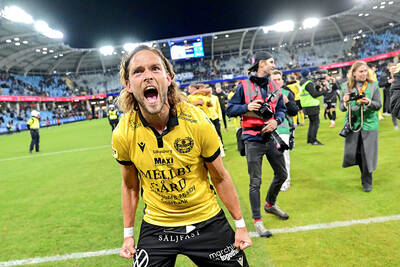Their interest piqued during COVID-19 lockdowns and by a new Netflix drama, a fresh rush of foreign tourists are flocking to Japan for a look inside the insular world of sumo.
Japan’s national sport — hundreds of years old and steeped in tradition — has long been a source of fascination outside the country, but those in the industry say interest has spiked in recent years, with some making the most of the new attention.
At a recent lunchtime “performance,” two imposing sumo practitioners strutted their stuff in a Tokyo restaurant full of cheering tourists.

Photo: AFP
Afterward, the spectators took selfies with the hulking athletes and donned padded sumo costumes and wigs to try their hand at the ancient art in a bout against retired professionals.
“The kids had a blast. I had a blast getting up there and fighting with them,” said Kiernan Riley, 42, from Arizona. “They put on a good show. Definitely one of the highlights of the trip.”
Tickets for the thrice-weekly event, which includes commentary in English and a slap-up meal, go for ¥11,000 (US$75.91) each and were sold out for the following six weeks.
One of the stars is former top professional wrestler Takayuki Sakuma, aka Jokoryu, who stands 1.87m tall and weighed 170kg at his peak.
“When you’re a professional, your life depends on sumo,” the now-retired 35-year-old said. “And it’s not to be taken lightly.”
“But to entertain people, we add humor. The most important thing is to make people appreciate sumo as culture,” he said.
Former amateur sumo wrestler John Gunning, who competed for his native Ireland and commentates — in English — on Japanese television, said there has been a “huge increase” in the sport’s popularity abroad over the past five to 10 years.
That popularity grew even more during COVID-19, when people stuck in lockdown explored new interests. The release this year of Sanctuary, a new Netflix series set in the world of sumo, also helped to introduce the sport to a new audience.
“I’m seeing a lot of people saying that that was their first exposure to sumo,” Gunning said.
The Japan Sumo Association last year also launched an English-language YouTube channel, “Sumo Prime Time,” whose videos rack up tens of thousands of views.
Ken Miller, 68, shows groups of American tourists the area of Ryogoku, a mecca for the sport, including the Ryogoku Kokugikan arena.
Each one pays several hundred dollars for the experience, and he said he is booked up for the next year.
Three times a year, in January, May and September, Kokugikan hosts the top stars of sumo in national tournaments in front of more than 10,000 cheering fans.
“I try to explain to them [the tourists] that sumo is not just a sport, it’s part of the culture, and it’s very much connected to Buddhism, Shinto,” Miller said. “It’s a way of life.”
Tourists have long been able to visit the hallowed interior of a “heya,” one of the traditional “stables” where sumo wrestlers live and train according to strict traditions.
Because of the growth in interest, many stables have banned individual visits and only allow group tours booked through an agency, guide Yuriko Kimura said.
“When we started sumo stable training tours, it was maybe held once or twice a week. People didn’t know about sumo, but then it surged around 2018-2019,” she said.
“I tell them that what is important is to show respect towards the stable and sumo wrestlers. If people from other countries know the dos and don’ts, they won’t do something wrong,” she added.
Inside, visitors must stay seated and quiet so as not to disturb the wrestlers while they train.
One stable, Arashio in central Tokyo, has a large bay window where dozens of people gather every day to watch the training sessions.
Yuka Suzuki, 61, the wife of the former master who installed the window, said that the original aim was to chip away at the reputation of sumo being “secretive.”
“But instead of locals, it’s people from all over the world who have started to come,” she said.
She added that she hoped that as a result, Japanese would start to rediscover their national sport, which she said was essential for its survival.
“Young wrestlers came into this world [of sumo] to test themselves, but if there are fewer and fewer Japanese people who feel that way, sumo wrestling will also disappear,” she said.

The Rakuten Monkeys on Sunday downed the CTBC Brothers 2-1, handing the hosts their second consecutive loss in the best-of-seven CPBL Taiwan Series at the Taipei Dome. Monkeys’ ace starter Pedro Fernandez of the Dominican Republic dominated on the mound, cruising through six scoreless innings before giving up a run on a wild pitch in the bottom of the seventh inning. He gave up only three hits and walked two batters in a 93-pitch outing, giving his Taoyuan-based team an edge. Offensively, the Monkeys’ leadoff batter Lin Li hit Brothers starter Brandon Leibrandt’s pitch over the center-field wall in the game’s first at-bat,

The tiny village club of Mjallby AIF on Monday won the top tier Swedish soccer league with a 2-0 away win at IFK Gothenburg, sealing the title with three rounds of matches remaining. Jacob Bergstrom and Tom Pettersson scored the goals in Mjallby’s 20th win in 27 league games. Mjallby has a population of fewer than 1,400 people and plays in an outdated 6,000-seat stadium with stands weathered by the winds of the Baltic Sea. “It’s a huge relief to experience this now, a relief with three games to go,” said Anders Torstensson, a former army officer and secondary-school teacher who coaches the

Jahmyr Gibbs was offered oxygen on the bench after a 78-yard run. He turned it down. Clearly, he was not out of breath. Gibbs on Monday scored on a long sprint in the second quarter, a five-yard spinning plunge in the third and accounted for a career-high 218 yards from the scrimmage to lead the Detroit Lions in a 24-9 win over the Tampa Bay Buccaneers. “You felt like this was coming,” Detroit coach Dan Campbell said. “This has been building.” The Lions (5-2) bounced back from a loss as they have done flawlessly for nearly three years, extending their NFL-long streak of 51 games

Marco Bezzecchi yesterday demolished the Australian MotoGP lap record in setting the standard during second practice, becoming the first rider ever to dip below 1 minute, 27 seconds at Phillip Island. The Italian, who won the Indonesia sprint race two weeks ago before slamming into world champion Marc Marquez during the grand prix, blazed around the waterfront circuit in 1 minute, 26.580 seconds on his Aprilia. His time shattered the previous best of 1 minute, 27.246 seconds set by Jorge Martin in 2023. Not content with that, he then bettered it with a sizzling 1 minute, 26.492 seconds. That left Bezzecchi 0.291 seconds